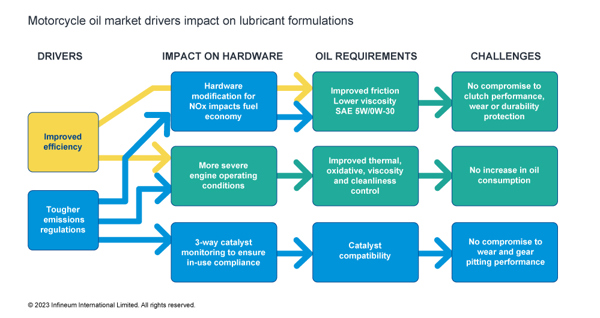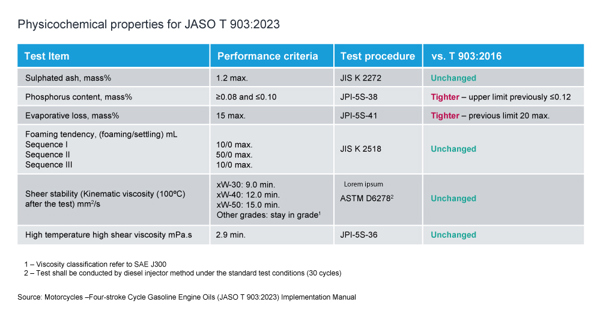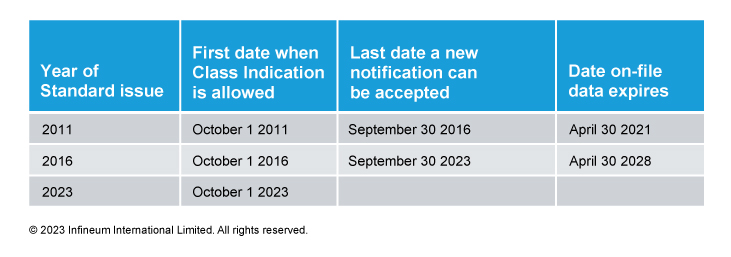Small Engines
Revving up for the new JASO specification
15 March 2023
04 July 2023
How tighter limits and changes to lubricant categories impact motorcycle oil formulations

To help meet tightening emissions regulations and to ensure the continued protection of the latest hardware the JASO T 903 motorcycle four-stroke cycle gasoline engine oils specification has been revised. Pradheep Veerapan, Infineum Small Engines Product Manager, explores the changes that have been made and shares his thoughts on what they mean for lubricant formulators.
Change in today’s motorcycle industry is driven primarily by the need to meet both tougher emissions regulations and the demands for improved efficiency. As engine designs evolve to meet these requirements, the operating conditions for the lubricant are becoming more severe. At the same time, lubricants are trending to lower viscosities and lower friction to achieve improved fuel economy performance. In addition, as emissions limits tighten, the use of three-way catalyst aftertreatment systems is needed. Here, the introduction of onboard diagnostic systems (OBD2), which phase in for Japan and Europe in 2023/24 and India in 2025, will introduce catalytic convertor monitoring to help ensure tailpipe emissions remain within the threshold limits over its lifetime in use.

All these changes mean that it is now essential for lubricants to not only deliver outstanding hardware protection at lower viscosities but also to support extended catalyst life. With these points in mind, the Society of Automotive Engineers of Japan (JSAE) has released a new revision to its JASO T 903:2023, motorcycle - four-stroke cycle gasoline engine oils specification, to ensure lubricants continue to protect the latest hardware. JSAE says the use of this standard will help customers select the right oil for their motorcycle and to reduce field problems resulting from the choice and use of inappropriate oils.
These revisions bring a number of changes to API categories and other performance standards, along with new requirements for phosphorus and evaporative loss. In addition, the new specification updates classification thresholds due to the changes in the reference oil and the friction material used in the clutch friction test, which was necessary owing to supply continuity issues. However, the long-awaited standard gear pitting test is not included in this revision.
The upper limit for phosphorus has been reduced to ensure three-way catalyst compliance. The minimum limit remains unchanged to ensure sufficient wear and gear pitting performance is maintained. In addition, evaporative loss limits have been lowered to help improve oil consumption and stabilise viscosity characteristics.

What it means to you
Alternative anti-wear chemistries and advanced formulation expertise will be required at these restricted phosphorus levels, especially at lower viscosity grades, to ensure wear protection, efficiency, and catalyst durability are maintained.
There have been changes to the API, ACEA and ILSAC target specifications with several performance categories being removed. These actions, combined with the addition of API SN PLUS and API SP, bring the opportunity for a real performance upgrade.
| Included | API SJ, SL, SM1, SN2 |
| Added | API SN PLUS2 and SP2 |
| Removed |
API SH and SG |
1 – Excluding SM/EC
2 - Excluding SN/RC, SN PLUS/RC, SP/RC
What it means to you
API SJ is now the minimum performance level needed to meet the JASO T 903:2023 specification requirements.
First licensing starts this year, with the first use of the logo indicating that a product conforms to the new specification allowable from October 1 2023. Current JASO T 903:2016 applications can be made until the end of September and current on file data will expire by April 30 2028.

What it means to you
Any remaining formulations registered under the 2011 version should be upgraded. Adding JASO T 903:2023 products to your portfolio gives you the opportunity to meet the protection requirements of current and future hardware.
The future-proof design built into our motorcycle oil products means we are ready to help you meet the requirements of the new JASO T 903:2023 motorcycle oil specification today.
Our portfolio has been re-evaluated and we have run extensive power, acceleration, and durability tests to ensure that our lower phosphorus motorcycle engine oil additive technology delivers the necessary performance in both higher and lower viscosity formulations. These results have been confirmed in extensive field trials.
Find your local Infineum representative here to talk about your four-stroke motorcycle oil requirements.
For additional details about the specification access the JASO T 903:2023 Implementation Manual here.
Sign up to receive monthly updates via email